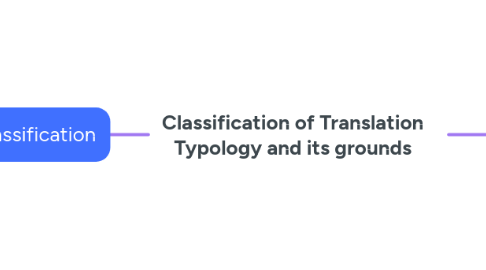
1. Komissarov's Classification
1.1. Psycholinguistic ground- According to the kinds of speech activity of translator done while the translation
1.1.1. Written- a translation which prepared in written way and it can be of different kinds: full written, abstract, annotation and others
1.1.2. Oral- is done orally while communication and it can be also classified into consequent, whispering and simultaneous interpretation.
1.1.2.1. Simultaneous interpretation
1.1.2.2. Consecutive interpretation
1.2. Genre-stylistic ground- According to genre of text presented for translation
1.2.1. Literary translation- is the translation of any kind of fictional work, including prose narratives, drama and poetry.
1.2.1.1. Simultaneous interpretation
1.2.1.2. Written interpretation
1.2.2. Specialized translation
1.2.2.1. 1. technical translation- is a specialization in its own right. It covers the translation of any material belonging to a particular area of knowledge, technical field or technology
1.2.2.2. 2. commercial translation covers all types of commercial documentation, such as invoices, contracts, transport documentation, customs documents, etc.
1.2.2.3. 3.financial translation encompasses any kind of financial documentation (company reports, financial statements, finance deals, contracts, stock market information, banking documents, fiscal information, etc.) related to the areas of finance, banking, taxes, stock exchange transactions and economic activity in general.
1.2.2.4. 4.legal translation covers all legal or legally binding documents such as laws, directives, standing orders, regulations or contracts.
1.2.2.5. 5.biomedical and pharmaceutical translation- this area of translation includes all kinds of documents relating to medicine and pharmaceutical products (e.g. research documentation, experimentation reports, analyses, test results, drug authorization requests, treatment protocols, etc.).
1.2.2.6. 6.scientific translation encompasses scientific research papers, theses, monographs, and various symposia and conference presentations, anything, in short, that is deemed to contribute to the advancement of science.
1.2.2.7. 7.IT translation translation refers to translations of any document relating to IT hardware or software.
1.2.2.8. 8.marketing and advertising translation
1.2.2.9. 9. translation of X documents
